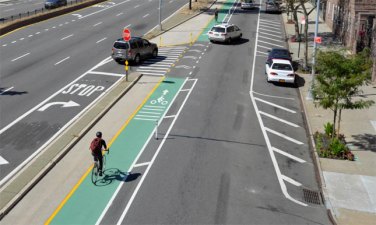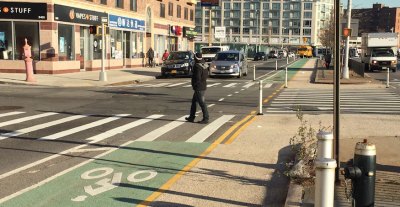The Boulevard of Life, Phase 2: DOT’s Plan for Queens Blvd in Elmhurst

Last night DOT presented a plan to redesign Queens Boulevard in Elmhurst with protected bike lanes and pedestrian safety improvements to Community Board 4 [PDF]. While local Council Member Danny Dromm has supported the project, DOT may have to proceed without an endorsement from CB 4, judging by the reactions of key board members.
Queens Boulevard is designed like a surface highway funneling east-west motor vehicle traffic across the borough. It’s unavoidable for people walking or biking, but also deadly.
DOT installed 1.3 miles of bike lanes and safer pedestrian space along the Queens Boulevard service roads in Woodside last year. The current plan would basically extend that design 1.2 miles from 74th Street to Eliot Avenue. A third phase through Rego Park and Forest hills is slated for 2017, and then capital reconstruction of the street would begin in 2018, casting the recent changes in concrete.
Like the design in Woodside, the next phase of the redesign aims to improve safety on Queens Boulevard by making the service roads function more like local streets, with more predictable motor vehicle movement and a continuous bike lane and pedestrian path running along the median.

The phase two segment may be the most dangerous part of Queens Boulevard. From 2010 to 2014, 777 people were injured in crashes within the project area, including 133 pedestrians and 20 cyclists. Most of the pedestrian victims — 54 percent — were struck while crossing the street with the signal, according to DOT. The pedestrian toll included four deaths and 17 severe injuries.
In addition to the bike lane, the project calls for calming traffic on the slip lanes between the central roadway and the service roads. By adding stop signs for drivers as they exit or enter the main road, the design seeks to discourage “lane shopping” and enhance pedestrian and cyclist safety.
DOT has been surveying people on the street, holding public workshops, and collecting feedback via an online portal since the fall. Of special concern are the blocks around the Queens Center Mall, where Queens Boulevard converges with Woodhaven Boulevard, the Long Island Expressway, and multiple subway entrances. In that area, the service roads are also significantly wider.

DOT wants to install a multi-lane bus loading zone in front of the mall’s entrance and shift the taxi stand further west in order to reduce conflicts between the two modes. And in what looks like an awkward sequence for cyclists, the westbound bike lane would jog over to the southern service road for a short stretch, then back to the northern side, in order to maintain the number of westbound motor vehicle lanes approaching the mall.

CB 4 Chair Louis Walker and District Manager Christian Cassagnol did not stake out explicit positions, but their questions echoed the skepticism hurled at Council Member Dromm when he spoke about the project at CB 4’s February meeting. Walker wondered why the bike lane was being proposed when “only two cyclists have been killed in this whole area.” (He was presumably referring to the two severe cyclist injuries in the project area between 2010 and 2014.)
In a tense exchange with committee member James Lisa, whose position on the bike lane bordered on total opposition, DOT’s Ann Marie Dougherty compared the redesign to Eastern Parkway and Ocean Parkway in Brooklyn. “We want people to come, we want people to use it,” she said. “We want it to be a sense of place for the community.”
In response, Lisa railed against the “threat” of bicyclists injuring pedestrians. “Only two people that were injured on Queens Boulevard — all of a sudden now you spend all this money to put a bike lane in for two people,” he said. “It makes no sense to me.”
Lisa was the only committee member in attendance last night, and there was no vote.
The meeting was the first of three between DOT and CB 4 regarding the Queens Boulevard redesign. DOT will brief the full board at its March 8 meeting and present the proposal again in April, when the board will vote on the project. DOT says the project can be implemented in June.


